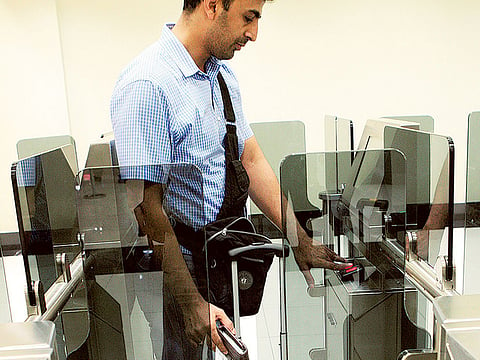E-gate more in use than Smart Gate
Only three centres still accept registrations — Dubai airport, GDRFA Headquarters and the Dnata office

Dubai: With the smart gate stealing the spotlight in technologically advanced immigration procedures, the e-gate seems to have taken a back seat. However, the e-gate is still more widespread than the smart gate with the latter being only deployed at the arrival wing at Terminal 3 in Dubai.
Dubai International Airport was the first airport in the region to implement the e-gate, when it was launched in the country in 2002. It was also the third airport in the world to do so. Once registered, travellers can use their e-gate card in most airports in the country, in both the arrivals and departures wings, an official from the General Directorate of Residency and Foreigners Affairs (GDRFA) said.
The e-gate card allows UAE visitors and residents to smoothly enter the country’s airport without having to wait in long passport queues. The e-gate scans the e-gate card and biometrics of the traveller before allowing them to pass through passport control. While the smart gate has a similar procedure, it is seven seconds faster when processing a passenger’s credentials.
While the e-gate requires an e-gate card, the smart gate, designed by Emaratech, can identify a traveller by either their passport, Emirates ID, e-gate card or QR barcode generated via the GDRFA smartphone app.
“Only three centres in Dubai still accept registration applications for an e-gate card,” he said. “One is the Dnata office in Business Bay, the second is the office at Terminal one and counters 20 and 21 here at the GDRFA main office.”
While the offices in Dnata and the GDRFA are operational only during office hours, the centre at the airport is open 24/7.
According to the GDRFA official, anyone above the age of 15 can register for an e-gate card. A passport with six months validity, a valid residency visa, a photograph and Dh200 are all that is required to register for an e-gate card. “Passport-holders should be present during first-time registration,” the official said. “This is not required for renewals.”
According to the official, the e-gate card expires with the passport or residency visa, whichever expires first.
“The e-gate is still the most widespread, deployed in most airports around the country, including Dubai Airports, Sharjah airport and Abu Dhabi airport,” the official said. “Though the smart gate is technologically superior, it is still only installed in the arrivals wing of Terminal three.”
Smart Gate
The GDRFA and Emaratech launched the mobile Smart Gate registration booth, giving residents the chance to register for the smart gate service free of charge. Most recently, the registration booth was deployed at Dubai Mall. According to GDRFA officials, around two million UAE residents and citizens have registered for the Smart Gate service so far.
Thani Abdullah Al Zafein, director-general and board member of tech major Emaratech, previously told Gulf News that a new generation of a traveller verification system was in the pipeline.
“The most advanced one in use now can clear an immigration process in about eight to 12 seconds. A new generation of smart gates will be implemented in the near future,” he said. “The new generation of smart gates will be even faster and will be able to simultaneously scan documents and irises. Passengers will almost be able to walk through the verification system without stopping.”
Al Zafein also mentioned plans to implement a smartphone app, which will act as a passenger guide through the airport processes leading up to boarding.
“We have to think from a passenger’s perspective when thinking about innovation at airports,” he said. “Generally, periods of waiting unnerve passengers the most. The trick is to turn unoccupied time to occupied time. The Smart Traveller is the next generation.”
Sign up for the Daily Briefing
Get the latest news and updates straight to your inbox



